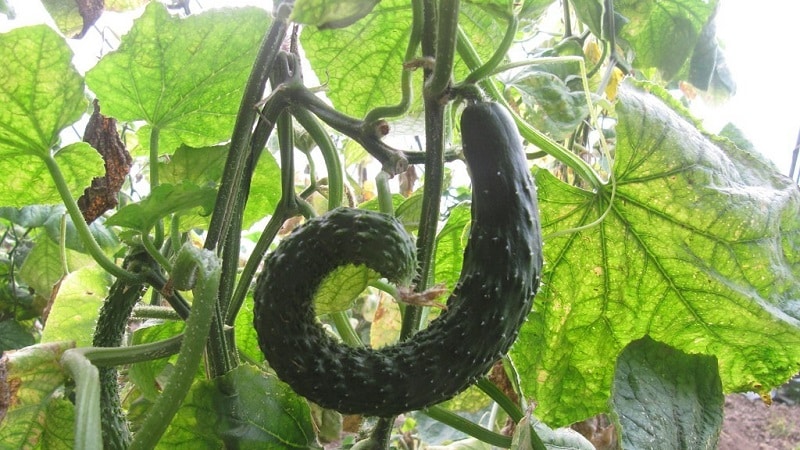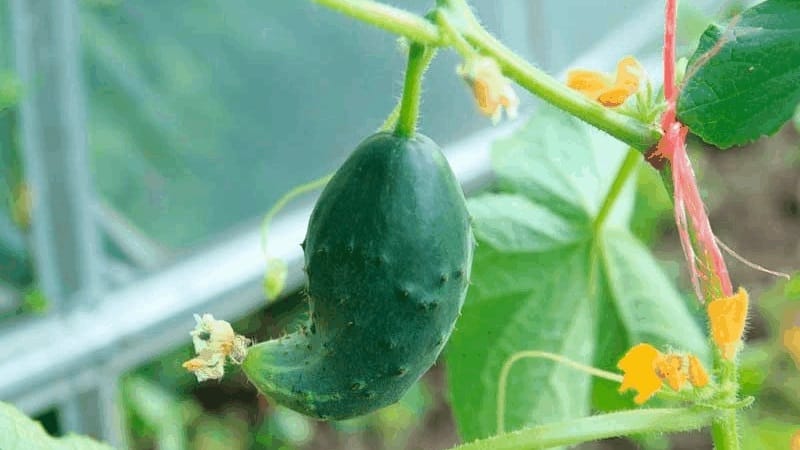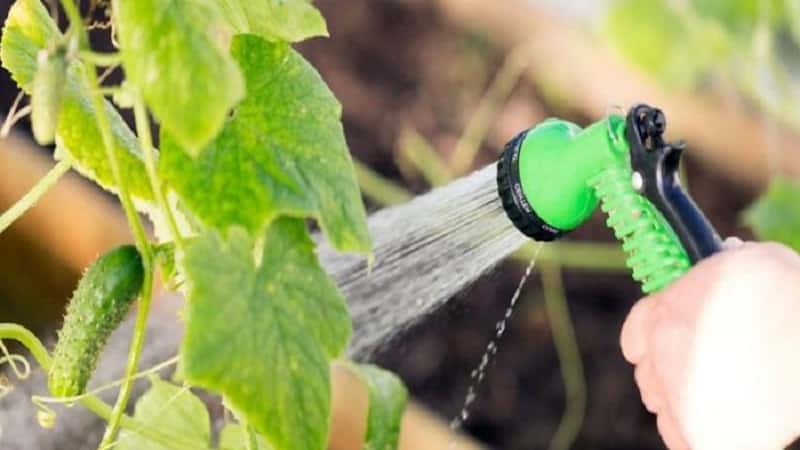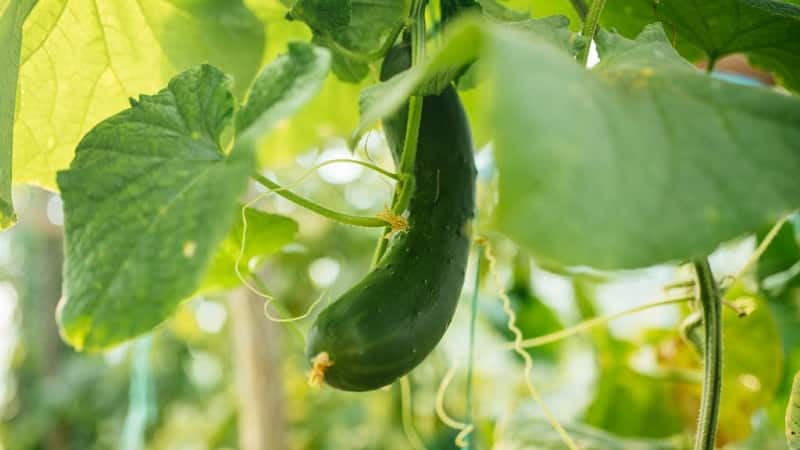What to do if cucumbers grow with a hook: what is missing and how to correct the situation
There are many varieties of cucumbers, but none that offer unusually shaped fruits. Such cucumbers are a sign of improper plant development. One of the most common deformations of cucumber fruits is the hook shape. It makes the cucumbers look unpresentable for sale and complicates the preservation process.
Why do cucumbers grow crooked, what does the plant lack, what to do about it and how to prevent it? You will find the answers in this article.
Why do cucumbers grow with crochets?
There are several reasons. Either one of them or their combination leads to the appearance of hook-shaped fruits on cucumber bushes. Most common reasons the fact that cucumbers grow with a hook is a lack of fertilizer, insufficient lighting and low temperature.

Fertilizer shortage
During the growing season, cucumbers are fed nitrogen-containing fertilizers, as they contribute to the rapid growth of the green mass of the bush. But nitrogen leaches potassium from the soil, which is so important for the formation and proper growth of fruits.
Important! It is the lack of potassium in the soil that most often causes cucumbers to become deformed.
With an excess of nitrogen and at the same time a lack of potassium and phosphorus in the soil, during flowering and fruiting, the ovaries of the plants fall off and the greens do not ripen.
Insufficient lighting
Cucumber is a light-loving plant. Ovaries on it are formed throughout the bush, including on the lower lashes. Overgrown green mass blocks access to sunlight to some ovaries, which leads to their falling off or deformation of the fruit.
If, in pursuit of a bountiful harvest, you have planted the plants too densely, do not be surprised at the hooked fruits, since the shadow from neighboring plants will also not let the sun's rays through to the cucumbers.
It can be useful:
How to deal with aphids on cucumbers in a greenhouse
Low temperature
Cucumbers grow comfortably at an air temperature of 20–26 °C. If it rises higher, the fruits turn yellow and wither. At temperatures below 20 °C, cucumbers become deformed or stop growing altogether.

The biggest danger is incorrect temperature conditions. in the last phase of the cucumber flowering period - immediately before fruiting begins. Errors at this stage can lead not only to crooked fruits, but also to the fall of the ovaries, that is, to a significant reduction in the yield.
Other reasons
If you find hook fruits on cucumber bushes, although all the reasons listed above are excluded, check whether you are harvesting on time and watering the plants correctly. If you do this correctly and on time, the reason may be a violation of the rules of the neighborhood or the characteristics of the chosen variety of cucumbers.
Late harvest
The cucumber bush spends a huge amount of energy and nutrients on ripening the fruits.. If the fruit is overripe and hangs for too long, the plant does not have enough strength to form new ovaries and normal ripening of new cucumbers.
Therefore, if you pick cucumbers rarely (less than once every two days), and especially at the end of the season, you will get crooked and small fruits on the cucumber bushes.The harvest will be several times smaller in quantity than it could have been if harvested in a timely manner.
Mistakes when watering
Watering is an important point when growing any plant, especially cucumber, because its fruits are 95% water. When watering cucumbers, you can make several mistakes that will lead to deformation of the fruit.:
- Cold water. Watering with cold and ice water stresses the roots of the plant, which leads to the appearance of empty flowers and deformed fruits.
- Lack of moisture. During drought, cucumbers wilt, so water is essential for growth and fruiting. During the flowering period, gardeners advise limiting watering the plant to produce female flowers. And if there is a lack of moisture during the fruiting period, the cucumbers appear small and uneven.
- Excess moisture. If there is excess moisture, microelements are washed out of the soil and do not reach the fruits, which means that mature, even and large cucumbers will not grow on such bushes. In addition, excess water will lead to root rot and death of the plant.

Violating Neighborhood Rules
Surprisingly, the appearance of beautiful, even, healthy fruits depends on the plants in the neighborhood with cucumbers. Cucumber varieties of different types of pollination should not be placed side by side. If self-pollinating plants and those that require insects for pollination are not isolated from each other, the fruits will be deformed.
Read also:
Features of the variety
Some varieties of cucumbers are characterized by produce more or less deformed fruits. Usually, hook fruits are formed in hybrids.Over many years of growing the crop, statistics have emerged regarding the formation of irregularly shaped cucumbers in a particular variety.
Record varieties for the number of irregularly shaped cucumbers (hooked, round, pot-bellied, pear-shaped, etc.) by the end of summer: Champion, Patti, Buyan, Prestige. Slightly less than half of the harvest is deformed in the second half of summer in the following varieties: Primadonna, Emelya, Talisman, Santana. Up to 30% of gnarled fruits are produced by the Pasadena and Pasamonte varieties.
A problem occurs in the greenhouse
Why do crooked cucumbers grow in a greenhouse? Growing cucumbers in a greenhouse can affect fruiting plants both positively and negatively. On the one hand, it is easier to maintain and regulate the conditions in which a crop grows in a greenhouse than in open ground. On the other hand, an inexperienced gardener can easily make a mistake, which will lead to improper development of fruits in the greenhouse.
In a greenhouse it is more difficult to isolate plants of differently pollinated varieties from each other and follow neighborhood rules. And for proper growth of insect-pollinated cucumbers in a greenhouse, you have to resort to artificial pollination.
Crochet cucumbers in open ground
When cucumbers grow in an open garden bed, the gardener it is more difficult to influence temperature conditions and watering (for example, during abnormal amounts of precipitation).
Easier in open ground, observe neighborhood rules, planting bushes of differently pollinated varieties in different places. At the same time, protecting self-pollinating cucumbers from insects is much more difficult than in a greenhouse.
What to do
If you notice twisted fruits on cucumber bushes, first determine the reasons for their appearance. Some of them can be easily fixed, others are much more difficult to deal with.:
- Take action immediately to avoid ending up with a whole crop of hooks. During the flowering and fruiting period, remove nitrogen-containing fertilizers from the fertilizing, add potassium and phosphorus.
- If the bushes are planted too close and shade the sunlight, and it is no longer possible to plant them wider, cut off the excess leaves. If this does not help, you will have to sacrifice some plants.
- Remember that at air temperatures below 20 ° C, cucumbers slow down or stop growing altogether, and the fruits are formed with a hook. Try to regulate the temperature in the greenhouse to the optimal temperature for cucumbers (20–26 °C), and in open ground, when it’s cold, stop watering the plants.
- It is necessary to harvest cucumbers every 2-3 days, at least. Experienced gardeners advise picking fruits slightly unripe. So the taste will be at its best, and nothing will harm the plant and future fruits.
- The ideal water for watering cucumbers is soft, rainwater, and room temperature. Carefully monitor watering of plants. If you find any violations, correct them. In hot weather and drought, water the bushes generously twice a day during the fruiting period. Do not overdo it with watering, so as not to spoil or completely destroy the crop.
- If you violate the rules of the neighborhood, you can artificially protect different varieties of cucumbers from each other, and some from insects. Block insect access to the greenhouse to save self-pollinating plants, and use artificial pollination for insect-pollinated plants. In open ground, it is better to cover self-pollinating bushes with gauze during the flowering period.

What to feed
To get a bountiful, healthy and beautiful harvest, plantings should be fertilized mullein, during flowering - chicken droppings, and during fruiting - ash.
Important! During the flowering and fruiting period, exclude nitrogen from the fertilizer complex and use potassium and phosphorus.
Fertilizing is a complex process when growing cucumbers.. Both a deficiency and an excess of useful elements in the soil leads to a poor harvest. The main elements for cucumbers are potassium, phosphorus, nitrogen, iron and copper.
Prevention measures
How to prevent fruits from starting to curl? It is necessary to comply with all conditions and rules for caring for cucumbers from the very beginning.. Then you won’t have to panic and take measures that don’t always lead to the expected result.
An important point in prevention is crop rotation.. First, cucumbers are not planted in the same soil for four years. Secondly, after crops such as pumpkin, zucchini and dill, there are practically no macro- and micronutrients left in the soil. This worsens the fruiting process and the cucumbers become deformed.
Special attention should be paid to the choice of variety. According to statistics, the fruits of the following cucumbers curl the least: Octopus, Twixie, Othello, Paratunka. For a greenhouse, choose self-pollinating varieties; for open ground, choose insect-pollinated varieties.
When boarding, pay attention to two points: proximity and distance between bushes. According to the rules, self-pollinating and insect-pollinated varieties of cucumbers must be planted as far as possible from each other (preferably at different ends of the greenhouse or plot).
Important! When planting, the distance between bushes growing nearby should be at least 10–20 cm so that they do not interfere with the penetration of sunlight.

Advice from experienced gardeners
Every gardener has at least once encountered hook cucumbers in the garden or in the greenhouse. Advice from experienced farmers will help you grow healthy, even and juicy fruits:
- Maintain crop rotation. The best predecessor crops for cucumbers are tomatoes, peppers, carrots, cabbage, and onions.
- For balanced moisture, mulch the soil with straw or peat after each watering.
- Stop watering when the air temperature is below 15 °C.
- Pick cucumbers 4–6 cm long from the vine.
- Once every two weeks, feed the cucumbers with an infusion of wood ash and potassium fertilizers.
- In late summer, use covered beds and greenhouses to avoid cold temperatures.
- Be sure to warm up water for irrigation in the sun, and in bad weather, boil and dilute with cold water.
- Carefully treat the greenhouse at the end of the season, disinfect it from diseases and pests that may have remained in the soil or located on the internal surfaces of the greenhouse.
Important! Water and spray cucumber bushes early in the morning (before 10:00) or in the evening (after 18:00). In hot weather, watering during the day may cause the plant to get sunburned.
Conclusion
Gardeners have different attitudes towards irregular cucumber harvest forms. Some people don’t care what a cucumber looks like, the main thing is that it is juicy and tasty. For others, it is important to grow cucumbers of the correct shape.
Remember: even fruits are an indicator that the plant is healthy and does not suffer from a lack or excess of any nutrients or improper care. Carefully follow the recommendations and advice for the prevention and control of deformed fruits, and your plantings will thank you for this with beautiful, tasty and crispy cucumbers.